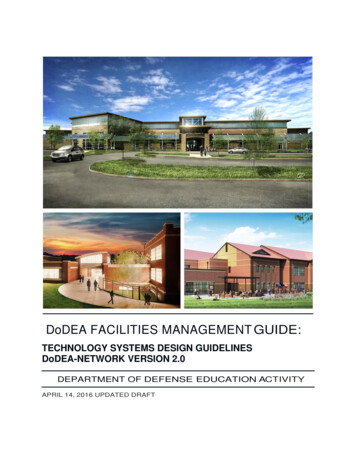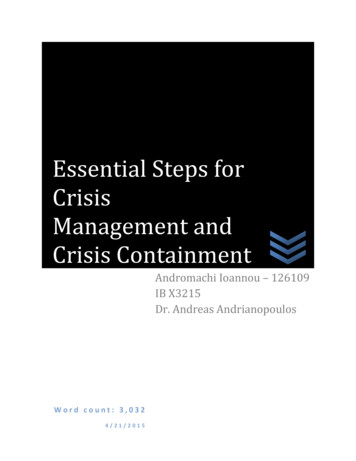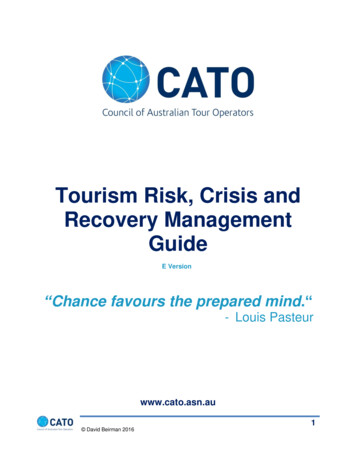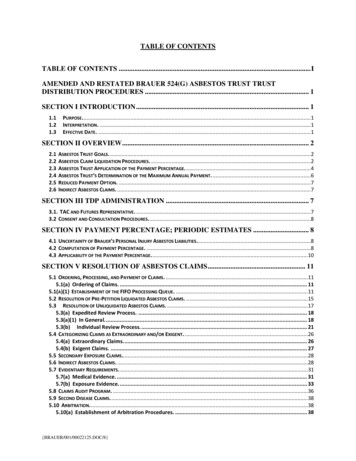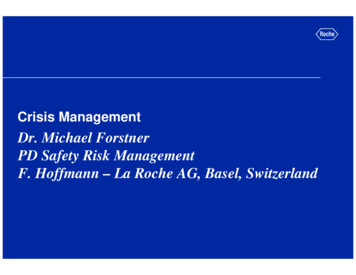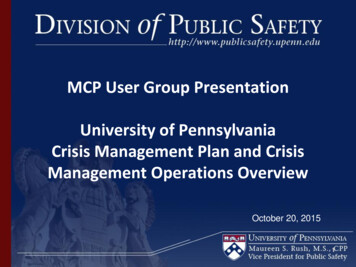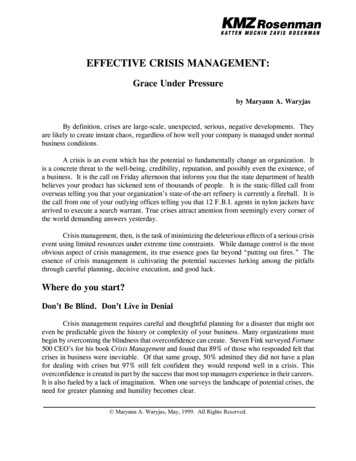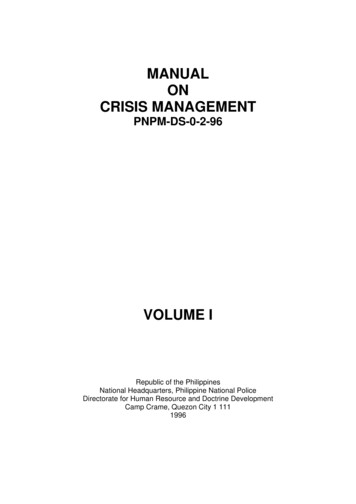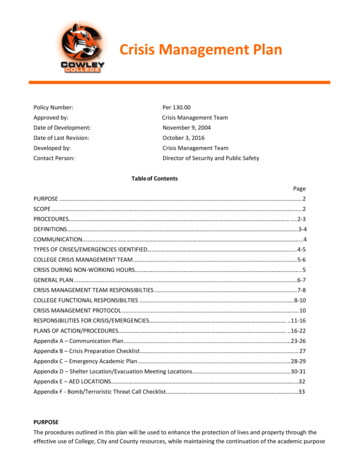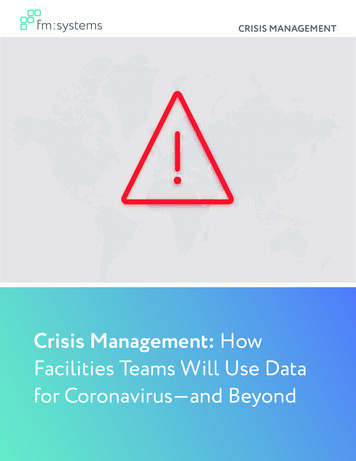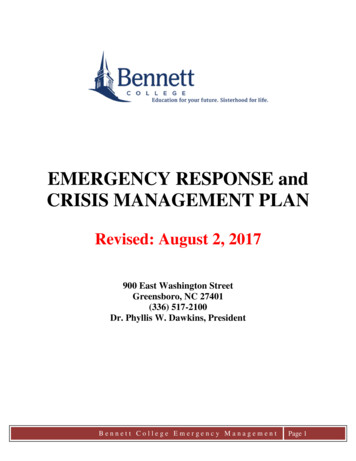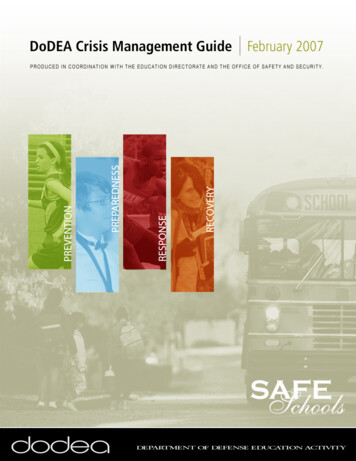
Transcription
ContentsCRISIS MANAGEMENT GUIDEContentsPreface.iiiIntroduction .1Crisis Management .3Prevention.3Preparedness .5Response .8Recovery .9AttachmentsPrevention (Tab 1).11 Suicide Awareness Deployment StressorsPreparedness (Tab 2) .16 Roles and Responsibilities of Crisis Management Team and Members Team Member Form Community Resource List Timeline for Establishment and Maintenance of Crisis Management Team Lists for Supplies and Emergency Kits Protective Actions StepsResponse (Tab 3) .27 Protective Actions Checklist Bomb Threat Form Hostage Situation Checklist Guidelines for Responding to Death Checklist for Response to Death Parent Notification of Student Death – Letter DoDEA Serious Incident Report Form Terrorism, Antiterrorism and Wari
ContentsCRISIS MANAGEMENT GUIDERecovery (Tab 4) .47 Risk Factors for Psychological Trauma Recovery Plan: Planning for the Psychological Aftermath of a SchoolTragedy General Guidelines for Group Processing of Critical Incidents Group Processing Procedures Special Considerations for Death by Suicide Teacher Guidelines for Talking About Death Memorial Service Guidelines for Death by Suicide Memorial Service Guidelines for Non-Suicidal Death Planning a Memorial Service for a School Staff Member Dealing with Natural DisastersGlossary (Tab 5) .65ii
PrefaceCRISIS MANAGEMENT GUIDEPrefaceThe Department of Defense Education Activity (DoDEA) Crisis ManagementGuide is a resource designed to assist school administrators and other personnelin understanding effective crisis management procedures and the role of thecrisis management team. A major focus of the guide is on Incident ResponsePlanning.The DoDEA Education Directorate and Office of Safety and Security, incollaboration with DynCorp (Safe Schools Program) developed this guide as aresource for school crisis teams. It is a supplement to Safe Schools: AHandbook for Practitioners. This guide incorporates practices and proceduresfrom DoDDS-Europe: A Guide to Crisis Management in the Schools (December2001), DoDDS-Pacific: Crisis Response Guide (August 2003), and the DDESS:Crisis Management Plan for Schools.Federal and national resources were also used and include the FederalEmergency Management Administration, the Department of Education and theDepartment of Defense. This guide has been peer reviewed by representativesfrom the American School Counselor Association, the Federal EmergencyManagement Agency, and the National Association of School Psychologists.This guide addresses the prevention of and response to crisis incidents asrelated to safety and security in DoDEA’s schools. Safety relates to safeguardingagainst injury, accidents, or danger to people and property. Security relates tosafeguarding against criminal acts or conditions of vulnerability that could resultin injury, loss of life or property. There is often an overlap between the areas ofsafety and security, as both view the health, safety and welfare of students astheir most important consideration.This Crisis Management Guide includes a description of the four areas of crisismanagement: prevention, preparedness, response, and recovery. Included arefour tabs corresponding to each area that include research articles and tools thatcan be used for many types of crises.The DoDEA Crisis Management Guide, dated February 2007, supersedes D.S.Manual 2943.0, DoDDS School Action Plan for Crisis Intervention and Responseto Death (February 1990), DoDDS-Europe: A Guide to Crisis Management in theSchools (December 2001), DoDDS-Pacific: Crisis Response Guide (August2003), and the DDESS: Crisis Management Plan for Schools.iii
IntroductionCRISIS MANAGEMENT GUIDEIntroductionCrisis management encompasses prevention of, and preparation for, a criticalincident or crisis event. It is a time-limited, problem-focused intervention toidentify, confront, and resolve a crisis event. Effective Crisis Managementrestores equilibrium, reduces emotional trauma, and supports appropriateadaptive responses from the affected community. Critical Incident – A situation that may disrupt the normal functioning of aschool community and can have a cognitive, physical, or emotional effectupon students, school staff, and community. Crisis Event – A situation that has harmed or threatens to greatly harmlife or property and requires outside assistance.Crisis management includes the planning components of Risk Reduction andIncident Response.1. Risk Reduction Planning (RRP) is a proactive approach that addressesPolicy, Prevention Programs, and Physical Security. RRP can also bethought of as the steps and actions necessary to prevent a critical incidentfrom occurring. DoDEA administrators have been trained in a Five-PhaseProcess found in Safe Schools: A Handbook for Practitioners. TheHandbook provides the tools and references necessary to implement SafeSchool Planning. The most important considerations of the Safety andCrisis Management Program are the health, safety and welfare of thestudents, staff and parents.2. Incident Response Planning (IRP) is preliminary planning designed tomanage critical incidents, in order to avoid a crisis, or in the event of acrisis – to react effectively. A well planned response managed skillfullyand effectively can prevent a critical incident from becoming a full blowncrisis. If delivered within a population that is well supported and educatedin effective coping skills, a single crisis event, with the potential for longterm trauma, can be transformed into an opportunity to generate healing,growth, and resiliency.The Crisis Management Team is a group of school staff trained in interventionand post-intervention procedures.Team members generally include theadministrator, school psychologist, school counselor, school nurse, a classroomteacher, and other professional staff as needed.1
IntroductionCRISIS MANAGEMENT GUIDEThe role/responsibility of the Crisis Management Team is to assist in: Developing a written crisis management plan to guide school staffin responding to a critical incident or crisis event,Coping with a critical incident which could lead to a crisis event,andResponding to a crisis event.The Crisis Management Plan addresses procedures for preventing, identifying,and responding to a critical incident, restoring equilibrium during and after theincident, assisting in emotional recovery from the trauma of an incident, andensuring appropriate communication with all stakeholders, and when appropriate,the public.Schools should develop individual Crisis Management Plans based upon theinformation presented in this guide. Plans may be customized to meet thespecific needs of each school community. For example, a useful reference is theDepartment of Education guide: Practical Information on Crisis Planningavailable on the Department of Education web site. Crisis Management Teams,drills of emergency procedures, communication protocols, and support structuresare all essential factors that come into play when a crisis event occurs. Chaos,confusion, anxiety, and escalation of stress can be greatly minimized if theseimportant factors have been addressed.2
Crisis ManagementCRISIS MANAGEMENT GUIDECrisis ManagementThe Crisis Analysis ModelThe Crisis Management Guide follows the U.S. Department of Education’s fourphases of Crisis Management: Prevention, Preparedness, Response andRecovery. The Crisis Analysis Model depicts the relationship between each ofthese components and the chronology of a crisis event.Crisis Analysis sIncidentResponsePrevention & PreparednessRecoveryResponse & RecoveryPREVENTIONPrevention is what the school can do to reduce or eliminate a critical incident orcrisis event. Prevention includes guidelines, programs, and physical securitymeasures that reduce the risk that a crisis will occur. Prevention efforts shouldtarget established concerns and risks for student populations.High-riskenvironments include conditions where bullying and harassment exist,depression and suicidal tendencies are undetected and unaddressed, substanceabuse is high and resiliency is low. Alleviating psychological stress on studentsis critical to preventing school violence perpetrated by students.The Crisis Team can help the principal assess the threat from individual studentsbased on early warning signs such as bullying or discipline referrals. Designingtargeted interventions for individual students can prevent a series of minorincidents from becoming a critical incident. Referring students to counseling orincluding them in a group intervention can provide the additional attentionneeded to prevent a serious incident. Typical group interventions are designed to3
Crisis ManagementCRISIS MANAGEMENT GUIDEdevelop effective decision making or conflict resolution skills. In addition,military-related issues such as deployment, force protection, and high operationstempo can have a significant effect on school functioning that would requirespecific interventions.Safe Schools: A Handbook for Practitioners equips administrators with the toolsto conduct an assessment of their school’s security vulnerabilities. Awareness isa significant factor in preventing school crime, violence and threatening incidentsthat affect the school community or its individuals. School leaders ensure thefollowing components regarding safety and security are in place and annualupdates on these three components are provided to staff, students, and parents.1. Policies/School Guidelines2. Prevention Programs3. Physical SecurityPolicies/School GuidelinesAdministrators can reduce the risk of violence by articulating DoDEA policies andschool guidelines that address safety and security issues. School guidelinesmust be clearly written, effectively communicated, and consistently enforced.When reviewing safety and security procedures, eliminate or revise those thatare not currently applicable. Do not establish procedures that are not needed.Make sure that procedures are in compliance with laws, regulations, andagreements.Prevention ProgramsPrevention programs help create a safe and secure learning environment byteaching effective life and decision-making skills, modeling positive behaviors,and reducing individual and group tension. DoDEA recognizes the importanceand value of preventative educational programs that address: Bullying and harassment;Symptoms of depression and suicidal tendencies;Teen dating violence;Substance abuse;Physical wellness; andDeveloping resilience.Additionally, due to the unique needs of military dependents during war-timedeployments, DoDEA recognizes a need for pro-active educational programs thatfocus on stresses of deployment, reintegration; and re-deployment.4
Crisis ManagementCRISIS MANAGEMENT GUIDESchools should have educational and guidance plans that target these concernsat various age levels and in a variety of settings to include: existing curriculum,counseling and guidance programs, and seminar and school-wide orientationprograms. Counselors and school psychologists often deliver these educationalprograms and supplement these efforts by providing individual and groupcounseling and mental health services to students, parents, and staff. Theseproactive educational and guidance programs are essential elements of a schoolprevention program.Physical SecurityPhysical security measures are addressed in DoDEA’s Safe Schools Handbook(see page 3-63) and should be applied only after completing a systematicanalysis of the school’s security needs. The main elements of considerationshould include: Assets to be protectedThreats likely to be facedEnvironment of the schoolContinual evaluation of physical security can be achieved through a series ofbroad functions. Select physical security solutions that supplement your effortsto deter, detect, delay, and/or investigate crimes and violence.PREPAREDNESSPreparedness focuses on the process of preparing for the worst-case scenario.Comprehensive preparedness must start with communication and collaborationwithin the school and community. Each individual must know his or her role andresponsibilities before a critical incident occurs. The following steps are essentialto preparedness:1.2.3.4.5.Establish a School Crisis TeamProvide Emergency Supply Kits (Administrator Grab-and-Go Kits)Establish Incident Command System relationships and proceduresPractice, Drill, ExerciseDevelop a Post-Crisis Recovery PlanEstablish a School Crisis TeamThe School Crisis Team is a group of key school personnel who will quicklyrespond to a critical incident.Team members generally include theadministrator, school psychologist, school counselor, school nurse, a classroomteacher and other professional staff as needed. The specific role of this teamand its members is to assess the incident, determine impact, and identify the preplanned response that is appropriate and relevant to the critical incident. Crisis5
Crisis ManagementCRISIS MANAGEMENT GUIDEManagement Team members should be trained and available to quickly mobilizeto address a range of immediate needs. For example, a nurse may be calledupon to administer CPR or other basic first aid procedures. Counselors may beassigned to communicate with troubled students—offering consolation anddiffusing anxiety.A description of the roles/responsibilities of Crisis Management Team members,a Sample Crisis Management Team List, and a Timeline for Annual CrisisPlanning are provided in the Preparedness Tab (pages 17-22).Provide Emergency Supply Kits (Administrator Grab-and-Go Kits)The Administrator Grab-and-Go Kit (not to be confused with classroom “Go Kits”)should contain all the items and information necessary for a school administratorto effectively manage the Critical and Post-Critical stages from an alternativelocation or the Incident Command Center. An individual will be assigned by theprincipal to help with this aspect of safe school planning. The administrator, oranother designated person, should be able to easily pick up the Grab-and-Go Kitas they evacuate the school office. Many schools put their kit in a rollingsuitcase. The kit should include key phone numbers, student rosters, and theCrisis Management Team Plan. These items will help guide schools through theappropriate actions to mitigate harm to the students and the school. A suggestedlist of items for inclusion in the Grab-and-Go Kit is provided in the PreparednessTab (page 23). The Emergency Supply List should be reviewed annually.Establish the Incident Command System Relationships and ProceduresWhen a critical incident is beyond the capability of the school staff, it becomes acrisis event and the Incident Command System (ICS) is activated. The ICS is anationally recognized organizational system used to address crisis events whena multi-agency response may be required. This system facilitates priority-setting,interagency cooperation, and the efficient flow of resources and informationnecessary during a crisis. All responding agencies (e.g., local/post/base policeand security officials, fire department, health/medical services, EOD/bombsquad, etc.) come together to: Determine the overall objectives and gain control of the critical situationSelect strategies to achieve objectivesPlan for response activitiesIntegrate necessary response operationsAt the installation level, adaptations to the ICS should be made to maximize theuse of both local and installation resources.6
Crisis ManagementCRISIS MANAGEMENT GUIDEPractice, Drill, and ExerciseDuring a critical incident, the school community must know what to do, how to doit, and where to do it. Practices, drills and exercises are outlined in DoDEA’sSafe Schools Handbook. Consult Chapter 2, page 2-14, for detailed informationregarding orientation seminars, emergency drills, tabletop exercises, functionalexercises and full-scale exercises.A Crisis Team’s ability to respondimmediately, effectively, and skillfully will be directly related to their rehearsedresponse to a given emergency scenario.Develop a Post-Crisis Recovery PlanThe Post-Crisis Recovery Plan describes what must be done after a crisis eventoccurs. The Post-Crisis Recovery period begins after an emergency responsehas stabilized any immediate threat or danger and may last an extended periodof time depending on the severity of the situation. The objective of the PostCrisis Recovery Plan should be to return the school to the state or condition ofnormalcy that existed prior to the crisis or as close to it as possible.A Post-Crisis Recovery Plan should address the management of the followingconcerns: Injury and death notificationsCasualty assistanceRumor controlMedia managementCounseling and support for grief and loss reactionsMemorial activitiesIdentification of symptoms of post-traumatic distressResiliency activitiesRelief effortsFollowing a crisis, administrators can expect to face the challenge of; educatingstudents to cope with the aftermath of a tragedy, reducing the fear that is beingexperienced by the students and faculty, and facilitating the grieving process.7
Crisis ManagementCRISIS MANAGEMENT GUIDERESPONSEResponse consists of the steps taken during a crisis. When responding to acritical incident, administrators, school staff/faculty, students and others mustknow what to do. When a school is experiencing an incident, the principal, ordesignee, should follow the easy three-step process (shown below) to implementan effective protective action. By internalizing this three-step process, theprincipal can rapidly and decisively choose a proper response.3 STEPS TO INCIDENT RESPONSEDETERMINETHETHREATDlEiamyncgeer#STAY INSIDE!DECIDECOURSE OFACTIONGO n-PlaceTake CoverEvacuateStep 1: Determine the Nature of the Crisis/IncidentThe School Crisis Team can assist the administrator in determining the nature ofthe incident. As soon as it is apparent that the situation is life threatening, theprincipal or designee should activate the ICS by phoning 911 or the appropriateemergency control number.Step 2: Decide on a Course of ActionIn the case of a crisis or incident that affects the entire school, basically there areonly two choices: Stay Inside or Go Outside. The proper course of actionshould either keep the threat from reaching the students or move the studentsaway from the threat.Note: Not all situations affect the entire student body. Treating one injuredstudent or notifying students of the death of a faculty member might constitute a8
Crisis ManagementCRISIS MANAGEMENT GUIDEcritical incident, but these incidents can be managed to de-escalate the situationand avoid crisis.Step 3: Implement a Protective ActionIf the decision is to stay inside, the nature of the threat will dictate whether tolockdown, shelter-in-place, or t
This Crisis Management Guide includes a description of the four areas of crisis management: prevention, preparedness, response, and recovery. Included are four tabs corresponding to each area that include research articles and tools that can be used for many types of crises. The DoDEA Crisis Manage
